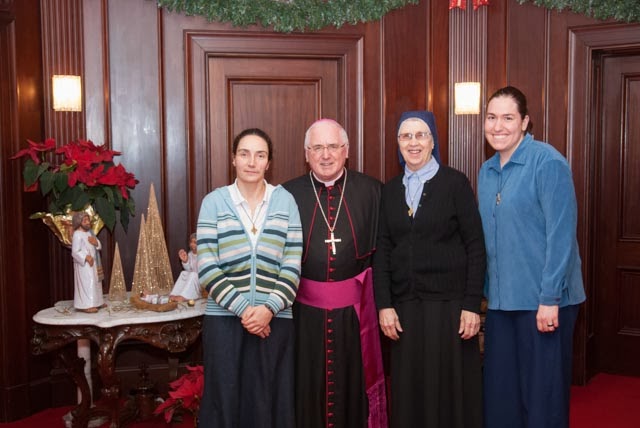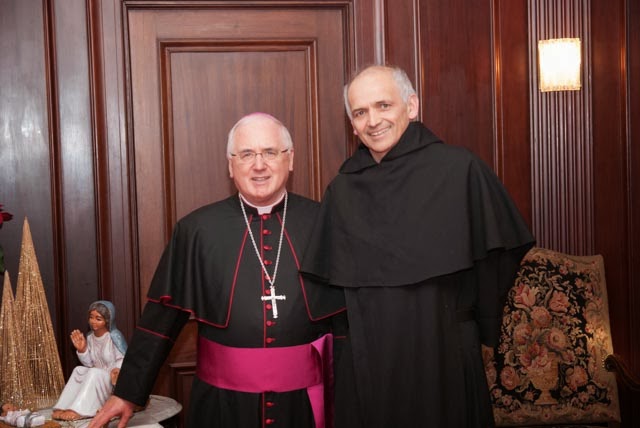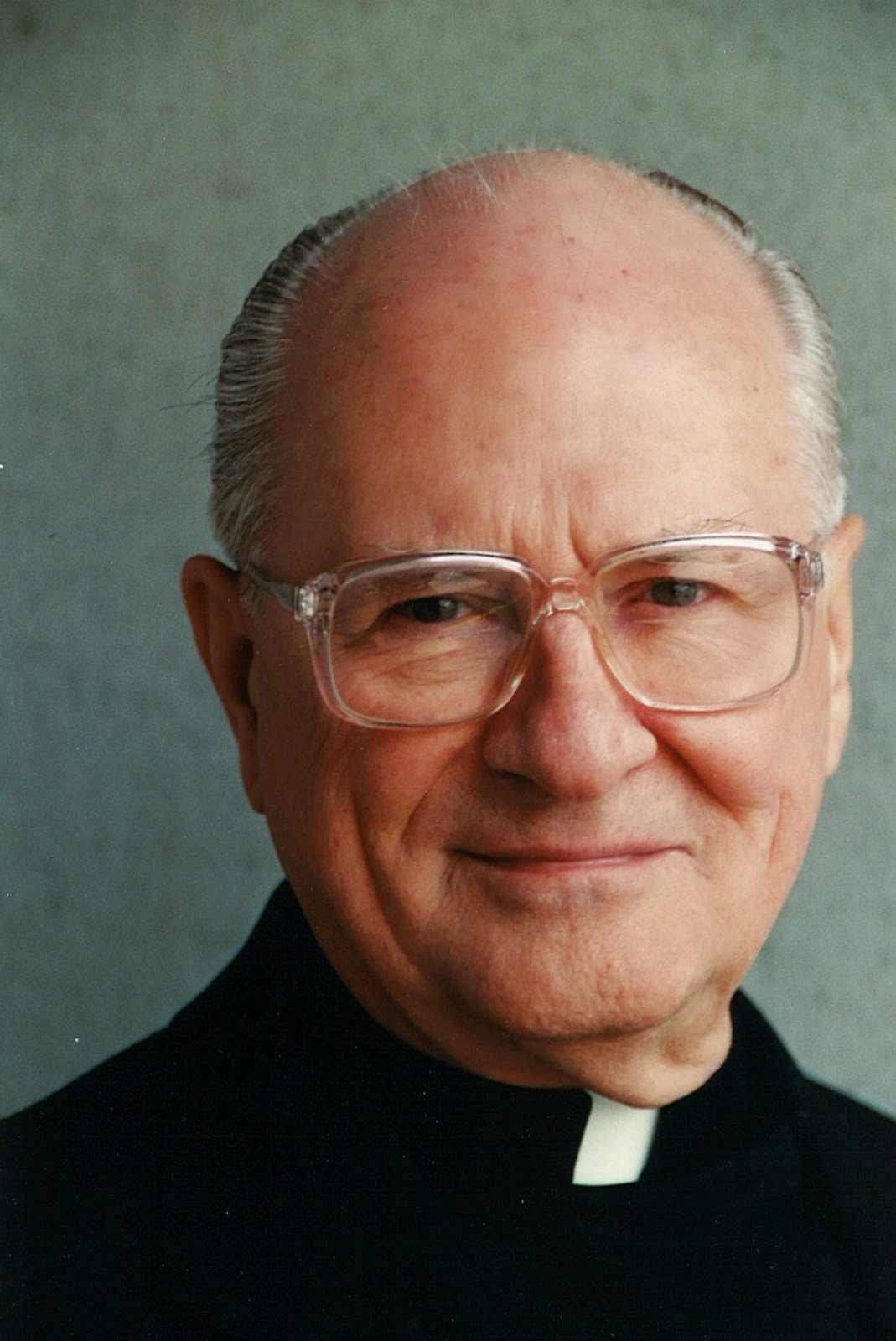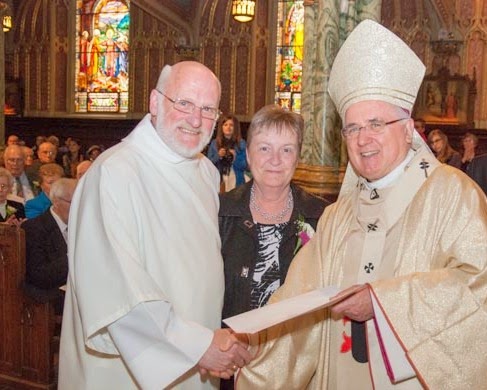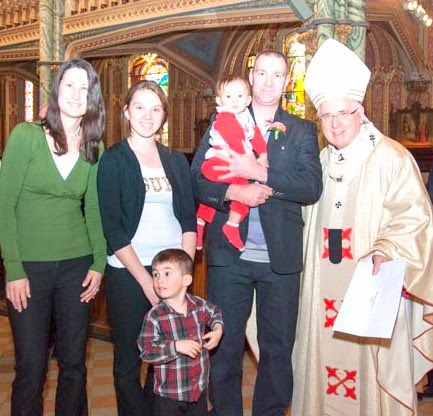On Sunday, I was able to accept Melkite Eparchial Bishop Ibrahim Ibrahim's invitation to visit his Saint Saviour Cathedral in Montreal on the Sunday when they were praying for Peace in Syria, Lebanon, Iraq and Egypt. At the close of Mass, the community presented me with a wood carving of the Blessed Mother Mary and her Infant Son.
Later, I joined the community in the Parish Hall for sweets, coffee and conversation. The Christians in the Middle East are all suffering greatly and many hearts are broken by the tragic situation in Syria which seems intractable and utterly ruinous. But the Christian families and individuals I met are persons of great joy.
Bishop Ibrahim invited me to speak on this occasion. My homily was predominantly in French and my prepared text follows immediately with an English version added on; the texts are interspersed with photos taken by Richard Bassila.
Let us continue to remember all our suffering Christian sisters and brothers, particularly those in Syria and Lebanon.
Messe pour la paix en Syrie et au Liban: Cathédrale melkite du Saint-Sauveur de Montréal
Dimanche, 16 février 2014
‘‘Glorifiez donc Dieu dans votre corps’’
[Textes : 1 Corinthiens 6, 12-20; Luc 15, 11-32]
Chers frères et soeurs dans le Christ,
Je suis très heureux de cette belle invitation que m’a faite votre évêque Mgr Ibrahim de venir le rencontrer et de venir vous rencontrer -et de célébrer avec vous - dans cette belle cathédrale, dans ma vie natale. J’ai passé la plus grande partie de ma jeunesse tout près d’ici, à Ahuntsic.
Cette Messe est offerte en intercession auprès de Dieu afin que la paix puisse revenir au Liban et en Syrie, deux pays que j’ai eu le privilège de visiter durant la Semaine sainte en 2010. Nous demandons à la bienheureuse Vierge Marie, la Mère de Dieu, et à tous nos saints patrons de bien vouloir intercéder pour nous afin que cesse la destruction, les effusions de sang, l’exil, et toutes ces autres horreurs qui émanent de la guerre en Syrie. Cette guerre apporte son lot de problèmes pour le Liban qui doit accueillir et venir en aide à un grand nombre de réfugiés, dont un bon nombre de chrétiens qui sont la cible de guerriers de part et d’autres. Demandons au Seigneur d’écouter notre prière et de bien vouloir y répondre de façon qui saura nous étonner.
Comme vous l’avez sans doute appris par les médias, le pape François invite l’Église à s’éloigner des tendances idéologiques et moralisatrices et à mettre plutôt ses efforts à proclamer l’Évangile. En effet, l’Église doit d’abord inviter les gens à reconnaître et à rencontrer Dieu dans le Christ. La droiture, la pratique de la moralité suivront. Lorsque nous découvrons la miséricorde de Dieu, nous pardonnons à notre tour et nous connaissons la joie. Il est arrivé parfois que cet ordre ait été renversé et cela a donné de bien mauvais résultats.
Nous venons d’entendre saint Paul inviter les Corinthiens à respecter leur corps, à vivre de manière pure. Cela n’était pas facile du temps de Paul, et cela n’est pas facile encore aujourd’hui. Il est important que nous nous tournions vers l’Évangile. Les Écritures Saintes nous apprennent que Dieu est comme ce père – que certains pourraient qualifier d’un peu fou – qui attend patiemment pendant des mois et des années que son fils qui vie dans péché et la misère revienne chez lui. Vous qui êtes du Moyen-Orient – un peu comme nous qui sommes descendants des autres cultures méditerranéennes –, vous auriez peut-être tendance à vouloir qualifier ce père d’un peu fou. Nous serions probablement tous tentés d’offrir à ce fils une bonne correction et à lui permettre de retrouver sa place dans la famille seulement après avoir passé un ‘test de bonne conduite’. Mais il n’en est pas ainsi pour Dieu le Père, le Père de notre Seigneur Jésus-Christ! Il souhaite tous nous accueillir dans son Royaume – la preuve c’est qu’il demande au fils aîné de participer à la fête.
![]()
C’est seulement après avoir pris connaissance de la grandeur de la miséricorde de Dieu tel que nous le révèle Jésus Christ que nous pouvons aborder les grandes questions qui touchent la moralité telles que l’avortement, la contraception, l’homosexualité, ainsi que les autres questions qui se présentent tout au long de notre vie. Un comportement moral est le résultat de la grâce de Dieu agissant en nous; ce n’est pas une précondition pour qu’une personne puisse faire partie de la communauté des élus ou de l’Église.
Normalement, les personnes ont besoin de rencontrer et de suivre le Seigneur un bon bout de temps avant de saisir pourquoi l’Église refuse l’avortement, le mariage des personnes du même sexe et la contraception.
Si on n’a pas placé le Seigneur au cœur de sa vie, il est difficile de comprendre le pourquoi de ces interdictions. Mais comment les gens peuvent-ils venir à connaître le Christ ? Les gens viennent à le connaître Jésus à travers le Peuple de Dieu – grâce à vous et moi – d’où l’importance de proclamer et de vivre l’Évangile. Il est important que nous partagions avec les autres ce que Jésus a fait pour nous, pour notre communauté, et pour nous personnellement. Je dois dire aux autres comment Jésus m’aime, comment Jésus m’a guéri, comment Jésus m’a sauvé. Ensuite, on doit laisser l’Esprit Saint faire son œuvre et prier pour les personnes que nous rencontrons.
Aujourd’hui, saint Paul nous invite à glorifier Dieu dans notre corps. Dans sa première épître aux Corinthiens, saint Paul vient ébranler les mœurs de son temps. L’argumentaire de l’apôtre est difficile à suivre parce que les manuscrits grecs n’avaient pas de ponctuation et de guillemets.
Paul emprunte des grecs une forme de rhétorique qu’on appelle la diatribe. Il utilise des idées qui avaient cours parmi les gens de Corinthe, pour les réfuter ensuite ou leurs partager ses propres idées.
Par exemple, il utilise l’expression qui avait cours parmi les fidèles de l’Église de Corinthe ‘Tout m’est permis’ pour y apporter le correctif suivant : ‘mais tout n’est pas profitable’ 6, 12).
L’argumentaire n’est pas toujours clair. Il est parfois difficile de discerner où commence ou se termine la pensée des Corinthiens et la réponse de Paul. Par exemple :
Paul : ‘’ Fuyez la fornication!’’
Objection des Corinthiens : [Mais pourquoi ?] ‘’Tout péché que l’homme peut commettre est extérieur à son corps’’
Paul : ‘‘Celui qui fornique, lui, pèche contre son propre corps.’’
Les chrétiens de Corinthe croyaient avoir bien raisonné l’affaire en disant que puisque le Christ était ressuscité, les actions qu’on pouvait porter contre son corps étaient sans importance. Paul s’objecta en disant que celui qui unit son corps à une prostituée, pèche contre son propre corps. Ses actions portent atteinte non seulement à l’Église mais à la personne elle-même. Cela constitue une véritable tragédie puisque le corps de chaque chrétien est temple de l’Esprit Saint.
Dans d’autres écrits, Paul se sert de l’image du temple pour faire référence à toute la communauté chrétienne, mais dans le passage que nous venons d’entendre Paul dit le corps de chaque chrétien est temple de l’Esprit et doit donc être traité avec dignité et respect.
Le texte se termine par un rappel que la vie nous vient de Dieu et que nous ne nous appartenons pas. Nous avons été bel et bien rachetés par le sang du Christ.
Paul ne nous dit pas que nous devons traiter notre corps avec respect afin d’y recevoir l’Esprit Saint, mais plutôt que nous devons traiter notre corps avec respect et dignité parce que l’Esprit Saint l’habite et en a fait son temple.
Aujourd’hui la fornication ou les relations sexuelles avec des prostituées portent encore atteinte au bien de la société. On parle également de relations charnelles entre personnes non mariés ou qui cohabitent sans être liées par les vœux du mariage. Ces situations existent à grande échelle dans notre société, même parmi les catholiques.
Cette situation porte atteinte au rôle primordial que doit avoir le mariage dans la structure familiale. La situation qui prévaut dans nos sociétés change la vie des familles…et pas toujours pour le mieux !
De nos jours, l’Église doit se pencher sur ces questions qui ont affaire avec la moralité sexuelle, de la même manière que Paul a dû le faire en son temps. Notre mission dans ce domaine consiste à aider les disciples de Jésus à bien comprendre le message de Jésus, à en voir la sagesse et les bienfaits et à accepter de le suivre. Faire confiance à Jésus, c’est accueillir son message et accepter de le suivre, c’est accepter de suivre les enseignements de son Église dans les grandes questions qui touchent la vie.
Je vous demande de bien vouloir prier pour moi. Puisse le Seigneur bénir chacun, chacune d’entre vous.
* * * * *
Mass for Peace in Syria and Lebanon—Saint Saviour Melkite Cathedral of Montreal
Sunday, February 16, 2014
“Glorify God in Your Body”
[Texts: 1 Corinthians 6.12–20; Luke 15.11-32]
Dear brothers and sisters in Christ,
I am pleased that today I am able to accept Bishop Ibrahim’s repeated invitation to visit him with his flock in his cathedral, in my home town of Montreal. I lived not far from here in Ahuntsic.
This Mass is being offered to intercede with God for peace in Lebanon and Syria, two countries that I had the joy of visiting in Easter Week 2010. We call on the powerful intercessory role of Our Blessed Mother Mary, as well as our patron saints, to join in obtaining for us an end to bloodshed, destruction, exile, and all the other horrors that come from the war in Syria and its impact on the Lebanese who are giving shelter to the refugees, particularly the many Christians who are being targeted. May God hear our prayer and answer them beyond our hopes and dreams.
As you may have heard in the media, Pope Francis wants to move the church away from ideological fixations of a moralizing sort and toward proclaiming the gospel. The order of church life must be inviting people to know God in Christ first. Then comes the moral order, as a response to one’s coming to know God’s mercy, forgiveness, and joy. Often the order gets reversed and that’s where trouble ensues.
That’s important in this liturgy when we hear the exhortation to the Church of Corinth to live in bodily purity, not easy in their day or in ours. It would be important for us to put the gospel first, our God is like the crazy father of the parable who waited patiently for months and years for his sinful son to return. You who know the Mediterranean culture would realize this man would be thought to be foolish: many fathers would want to reprimand their sons and let them be readmitted after probation. But not the Father of Our Lord Jesus Christ. He wishes us all to be brought into communion in the happy family of God’s kingdom—the proof of that is his pleading with the older son to join the feast.
![]()
Only once we have heard the good news of Jesus Christ’s image of the loving and merciful Father can we address the other issues of a moral sort. Here then is where the issues of abortion, contraception, active homosexuality, and other life issues come in. Virtuous behaviour in these areas is a response to God’s grace, not a pre-condition to belonging to the community of God’s Kingdom and the Church.
Most people need a close walk with the Lord to understand why the Church says no to abortion, gay marriage, and contraception.
Without Jesus deeply in your life, it is hard to understand these prohibitions. But how do people get to know Jesus? People get to know him by God’s people—you—evangelizing and telling them about your Lord and Saviour. By you telling a person you know what Jesus has done for us and for you in particular. You must tell that person how Jesus has saved you, loved you, and healed you. Then you must let the Holy Spirit take over as you pray for that person.
Today, Paul invites you and me to “glorify God in your body”. His First Epistle to the Corinthians challenges social conventions. Not only those of the first century society in which he lived, but those of our time too. The Apostle's argument is a little difficult to follow because Greek manuscripts had no punctuation, let alone quotation marks.
In his presentation, Paul made use of the Greek style of rhetorical discourse (the diatribe). He cited statements current in the Church at Corinth, then gave his own view, usually a refutation or correction.
For example, many scholars believe the first part of this discussion began with Paul quoting a Corinthian slogan about Christian freedom, “All things are lawful for me”, which he qualified with the rejoinder, “but not all things are beneficial” (6:12).
The argumentation is not always clear, since at times it is not evident where Corinthian positions begin or end and where Paul's remarks come into play. Here is a reconstruction of the dialogue that makes sense to me.
Paul: "Flee fornication!"
Corinthians [objecting]: ["But why?] Every sin a person commits is outside the body".
Paul: "But the fornicator sins against his own body."
The "enlightened" Corinthian Christians were saying that, because of Christ's resurrection, bodily actions were of no significance. Paul objected, saying that, by linking his body with a prostitute, a fornicator sinned against his own body. His actions hurt not only the church but also himself. This was tragic because each individual Christian's body is a temple of the Holy Spirit.
In other places, Paul had used the temple imagery in reference to the whole Christian community. Here he transfers the metaphor to each individual disciple of Jesus. He says that each individual's body should be kept as a disciplined holy vessel fit for the Spirit who dwells in the believer.
This section ends with a reiteration of the notion that each person's body is not the individual's personal property to do with as he or she pleases. Paul insisted that by the ransom from bondage to sin achieved for each person by Christ's death on the cross, “you are not your own...you were bought with a price”.
In this passage, Paul moves regularly from a declaration about what God in Christ has achieved for the Christian (the indicative) to how the individual must now live (the imperative). For example, Paul does not say that one should keep the body holy so that God may offer you the Spirit, but rather, because the Holy Spirit already dwells in you, you should keep your body from fornication.
Today, fornication as a sin committed by an individual with a prostitute is still an affliction of society. It is also the objective description of those who engage in sexual activity outside marriage and those who cohabit without benefit of marriage. As such, and in a change from past experience, it has become widespread in society, even among Catholics.
The negative effects of this situation is a factor in the declining centrality of marriage in family structure. It is a phenomenon altering the face of family life in first-world countries.
Today, the Church needs to engage this issue of sexual morality as Paul did the views of the Corinthians. The challenge is to help disciples see that faith in Jesus today involves embracing His views—communicated by the Church—on the major issues of life.
Please pray for me. God bless you one and all.















